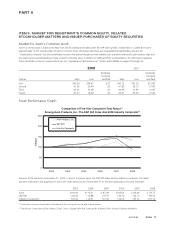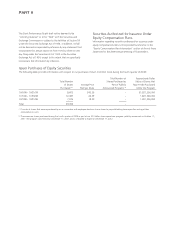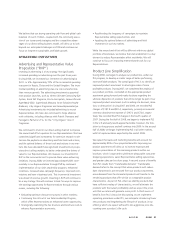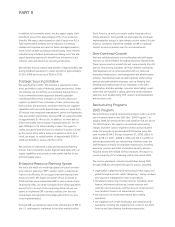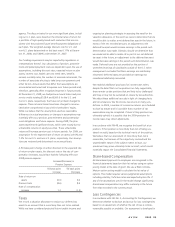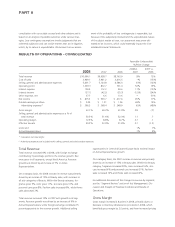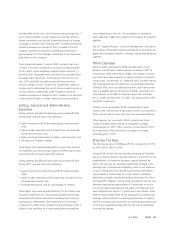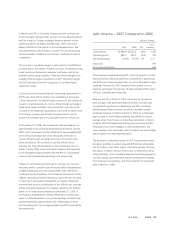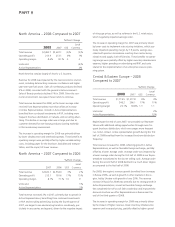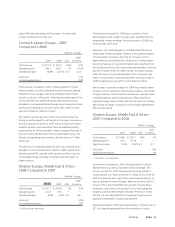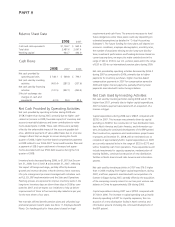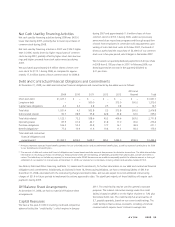Avon 2008 Annual Report Download - page 31
Download and view the complete annual report
Please find page 31 of the 2008 Avon annual report below. You can navigate through the pages in the report by either clicking on the pages listed below, or by using the keyword search tool below to find specific information within the annual report.
agency. The discount rates for our more significant plans, includ-
ing our U.S. plan, were based on the internal rates of return for
a portfolio of high quality bonds with maturities that are con-
sistent with the projected future benefit payment obligations of
each plan. The weighted-average discount rate for U.S. and
non-U.S. plans determined on this basis was 6.11% at Decem-
ber 31, 2008, and 5.88% at December 31, 2007.
Our funding requirements may be impacted by regulations or
interpretations thereof. Our calculations of pension, postretire-
ment and postemployment costs are dependent upon the use of
assumptions, including discount rates, expected return on plan
assets, interest cost, health care cost trend rates, benefits
earned, mortality rates, the number of associate retirements, the
number of associates electing to take lump-sum payments and
other factors. Actual results that differ from assumptions are
accumulated and amortized to expense over future periods and,
therefore, generally affect recognized expense in future periods.
At December 31, 2008, we had pretax actuarial losses and prior
service credits totaling $538.4 and $260.6 for the U.S. and
non-U.S. plans, respectively, that have not yet been charged to
expense. These actuarial losses have been charged to accumu-
lated other comprehensive loss within shareholders’ equity.
While we believe that the assumptions used are reasonable,
differences in actual experience or changes in assumptions may
materially affect our pension, postretirement and postemploy-
ment obligations and future expense. During 2008, the plan
assets experienced significant losses, which were mostly due to
unfavorable returns on equity securities. These unfavorable
returns will increase pension cost in future periods. For 2009, our
assumption for the expected rate of return on assets is 8.0% and
7.2% for our U.S. and non-U.S. plans, respectively. Our assump-
tions are reviewed and determined on an annual basis.
A 50 basis point change (in either direction) in the expected rate
of return on plan assets, the discount rate or the rate of com-
pensation increases, would have had the following effect on
2008 pension expense:
Increase/(Decrease) in
Pension Expense
50 basis point
Increase
50 basis point
Decrease
Rate of return on
assets (6.0) 6.0
Discount rate (8.6) 8.4
Rate of compensation
increase 1.2 (1.5)
Taxes
We record a valuation allowance to reduce our deferred tax
assets to an amount that is more likely than not to be realized.
While we have considered projected future taxable income and
ongoing tax planning strategies in assessing the need for the
valuation allowance, in the event we were to determine that we
would be able to realize a net deferred tax asset in the future, in
excess of the net recorded amount, an adjustment to the
deferred tax asset would increase earnings in the period such
determination was made. Likewise, should we determine that
we would not be able to realize all or part of our net deferred
tax asset in the future, an adjustment to the deferred tax asset
would decrease earnings in the period such determination was
made. Deferred taxes are not provided on the portion of
unremitted earnings of subsidiaries outside of the U.S. when
management concludes that these earnings are indefinitely
reinvested. Deferred taxes are provided on earnings not
considered indefinitely reinvested.
We establish additional provisions for income taxes when,
despite the belief that our tax positions are fully supportable,
there remain certain positions that are likely to be challenged
and may or may not be sustained on review by tax authorities.
We adjust these additional accruals in light of changing facts
and circumstances. We file income tax returns in many juris-
dictions. In 2009, a number of income tax returns are scheduled
to close by statute and it is possible that a number of tax
examinations may be completed. If Avon’s filing positions are
ultimately upheld, it is possible that the 2009 provision for
income taxes may reflect adjustments.
In accordance with FIN 48, we recognize the benefit of a tax
position, if that position is more likely than not of being sus-
tained on audit, based on the technical merits of the position.
We believe that our assessment of more likely than not is
reasonable, but because of the subjectivity involved and the
unpredictable nature of the subject matter at issue, our
assessment may prove ultimately to be incorrect, which could
materially impact the Consolidated Financial Statements.
Share-based Compensation
All share-based payments to employees are recognized in the
financial statements based on their fair values using an option-
pricing model at the date of grant. We use a Black-Scholes-
Merton option-pricing model to calculate the fair value of
options. This model requires various judgmental assumptions
including volatility, forfeiture rates and expected option life. If
any of the assumptions used in the model change significantly,
share-based compensation may differ materially in the future
from that recorded in the current period.
Loss Contingencies
In accordance with FAS No. 5, Accounting for Contingencies,we
determine whether to disclose and accrue for loss contingencies
based on an assessment of whether the risk of loss is remote,
reasonably possible or probable. Our assessment is developed in
A V O N 2008 25




